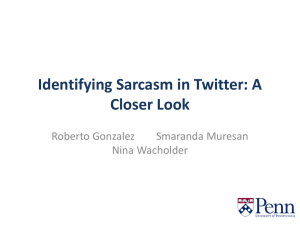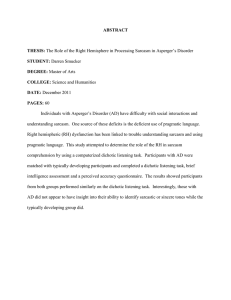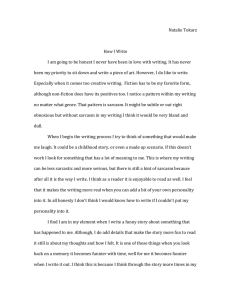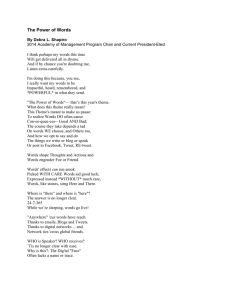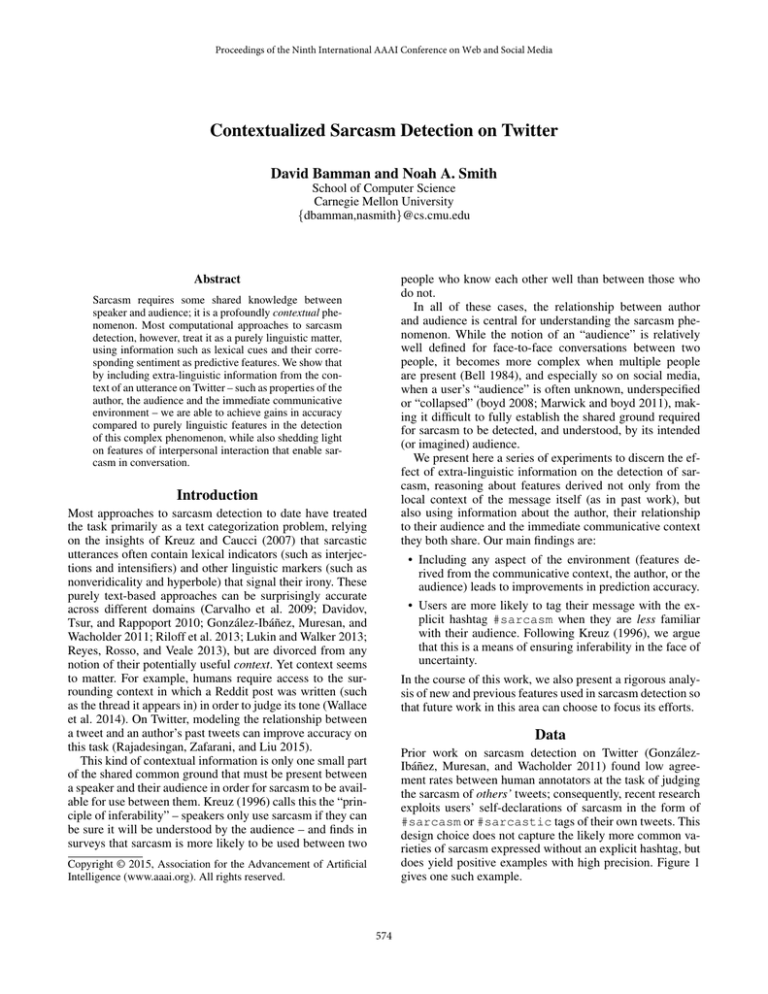
Proceedings of the Ninth International AAAI Conference on Web and Social Media
Contextualized Sarcasm Detection on Twitter
David Bamman and Noah A. Smith
School of Computer Science
Carnegie Mellon University
{dbamman,nasmith}@cs.cmu.edu
Abstract
people who know each other well than between those who
do not.
In all of these cases, the relationship between author
and audience is central for understanding the sarcasm phenomenon. While the notion of an “audience” is relatively
well defined for face-to-face conversations between two
people, it becomes more complex when multiple people
are present (Bell 1984), and especially so on social media,
when a user’s “audience” is often unknown, underspecified
or “collapsed” (boyd 2008; Marwick and boyd 2011), making it difficult to fully establish the shared ground required
for sarcasm to be detected, and understood, by its intended
(or imagined) audience.
We present here a series of experiments to discern the effect of extra-linguistic information on the detection of sarcasm, reasoning about features derived not only from the
local context of the message itself (as in past work), but
also using information about the author, their relationship
to their audience and the immediate communicative context
they both share. Our main findings are:
Sarcasm requires some shared knowledge between
speaker and audience; it is a profoundly contextual phenomenon. Most computational approaches to sarcasm
detection, however, treat it as a purely linguistic matter,
using information such as lexical cues and their corresponding sentiment as predictive features. We show that
by including extra-linguistic information from the context of an utterance on Twitter – such as properties of the
author, the audience and the immediate communicative
environment – we are able to achieve gains in accuracy
compared to purely linguistic features in the detection
of this complex phenomenon, while also shedding light
on features of interpersonal interaction that enable sarcasm in conversation.
Introduction
Most approaches to sarcasm detection to date have treated
the task primarily as a text categorization problem, relying
on the insights of Kreuz and Caucci (2007) that sarcastic
utterances often contain lexical indicators (such as interjections and intensifiers) and other linguistic markers (such as
nonveridicality and hyperbole) that signal their irony. These
purely text-based approaches can be surprisingly accurate
across different domains (Carvalho et al. 2009; Davidov,
Tsur, and Rappoport 2010; González-Ibáñez, Muresan, and
Wacholder 2011; Riloff et al. 2013; Lukin and Walker 2013;
Reyes, Rosso, and Veale 2013), but are divorced from any
notion of their potentially useful context. Yet context seems
to matter. For example, humans require access to the surrounding context in which a Reddit post was written (such
as the thread it appears in) in order to judge its tone (Wallace
et al. 2014). On Twitter, modeling the relationship between
a tweet and an author’s past tweets can improve accuracy on
this task (Rajadesingan, Zafarani, and Liu 2015).
This kind of contextual information is only one small part
of the shared common ground that must be present between
a speaker and their audience in order for sarcasm to be available for use between them. Kreuz (1996) calls this the “principle of inferability” – speakers only use sarcasm if they can
be sure it will be understood by the audience – and finds in
surveys that sarcasm is more likely to be used between two
• Including any aspect of the environment (features derived from the communicative context, the author, or the
audience) leads to improvements in prediction accuracy.
• Users are more likely to tag their message with the explicit hashtag #sarcasm when they are less familiar
with their audience. Following Kreuz (1996), we argue
that this is a means of ensuring inferability in the face of
uncertainty.
In the course of this work, we also present a rigorous analysis of new and previous features used in sarcasm detection so
that future work in this area can choose to focus its efforts.
Data
Prior work on sarcasm detection on Twitter (GonzálezIbáñez, Muresan, and Wacholder 2011) found low agreement rates between human annotators at the task of judging
the sarcasm of others’ tweets; consequently, recent research
exploits users’ self-declarations of sarcasm in the form of
#sarcasm or #sarcastic tags of their own tweets. This
design choice does not capture the likely more common varieties of sarcasm expressed without an explicit hashtag, but
does yield positive examples with high precision. Figure 1
gives one such example.
Copyright © 2015, Association for the Advancement of Artificial
Intelligence (www.aaai.org). All rights reserved.
574
report in parentheses the tenfold cross-validated accuracy of
a model trained only on that feature type.
Tweet Features
Figure 1: User self-reporting of sarcasm.
We follow the same methodology here as well, identifying the authors of all tweets mentioning #sarcasm or
#sarcastic in the Gardenhose sample of tweets from
August 2013–July 2014, and crawling up to the most recent
3,200 tweets of those authors. As in past work, we label a
tweet as S ARCASTIC if it contains the hashtag #sarcasm
or #sarcastic as its final term, is written in English, is
not a retweet, and contains at least three words. To explore
the influence of the communicative context on our perception of sarcasm, we further subsample this set to include
only tweets that are responses to another tweet. This yields
a positive training set of 9,767 tweets; for negative data,
we select an equal number of tweets from users over the
same time period who have not mentioned #sarcasm or
#sarcastic in their messages. The total dataset is evenly
balanced at 19,534 tweets. Since the hashtags #sarcasm
and #sarcastic are used to define the positive examples,
we remove those tags from all tweets for the prediction task.
Experimental Setup
For the classification task of deciding whether a tweet is
S ARCASTIC or N OT S ARCASTIC, we adopt binary logistic regression with `2 regularization using tenfold crossvalidation, split on authors (so that tweets by the same author
do not appear in multiple splits). We tune the `2 regularization parameter on development data (train on 8⁄10, tune on
1⁄ , test on the remaining held-out 1⁄ ) and repeat across ten
10
10
folds. We perform this cross-validation and parameter tuning for every feature combination reported below, since different feature sets (with different cardinalities) will result in
different optimal parameter settings.
Features
We can divide the features used in our models into four
classes: those scoped only over the immediate tweet being
predicted (§Tweet Features); those that reason over the author of that tweet, including historical data by that author
(§Author Features); those that reason over the addressee of
the tweet (the person to whom the target tweet under consideration is responding), including historical data for that
individual and the author’s history of interaction with them
(§Audience Features); and features that consider the interaction between the tweet being predicted and the tweet that it
is responding to (§Response Features).
The baseline accuracy, using only the majority class in
each training fold, is 47.4% (this is lower than an even 50%
since the folds are split by author and contain varying numbers of tweets). In describing each feature below, we also
• Word unigrams (72.4%) and bigrams (69.5%). We create
binary indicators of lowercased word unigrams and bigrams.
The most indicative unigrams include dare, shocked, clearly,
#lol and gasp, and the most indicative bigrams include you
mean, how dare, i’m shocked, i’m sure and at all.
• Brown cluster unigrams (72.0%) bigrams (69.1%). For
dimensionality reduction, we map each word in our vocabulary to one of 1000 non-overlapping clusters using the
Brown clusters of Owoputi et al. (2013), which group words
used in similar contexts into the same cluster. We compute
unigrams and bigrams over terms in this reduced space.
• Unlabeled dependency bigrams, lexicalized (70.3%) and
Brown clusters (70.2%). We create binary features from
unlabeled dependency arcs between a.) two words and b.)
their corresponding Brown clusters after parsing the tweet
with TweeboParser (Kong et al. 2014).
• Part of speech features (66.0%). Past work has shown that
part of speech information (such as the density of hashtags
and emoticons) is among the most informative for this task.
We apply the POS tagger of Owoputi et al. (2013) and include features based on the absolute count and ratio of each
of the 25 tags, along with the “lexical density” of the tweet,
which models the ratio of nouns, verbs, adjectives and adverbs to all words (Rajadesingan, Zafarani, and Liu 2015).
• Pronunciation features (57.5%) To model the use of
Twitter-specific writing style (as in Rajadesingan et al.,
2015), we include the number of words with only alphabetic
characters but no vowels (e.g., btw) and the number of words
with more than three syllables.
• Capitalization features (57.5%). We include the number of
words with initial caps and all caps and the number of POS
tags with at least initial caps.
• Tweet whole sentiment (55.0%). We include several types
of tweet-level sentiment features. The first is a feature containing the numeric value of the entire tweet’s sentiment as
determined by the Stanford Sentiment Analyzer (Socher et
al. 2013); since this phrase-based analyzer also determines
the sentiment value of each non-terminal node in its syntactic parse tree, we also include the fraction of nonterminals
with each sentiment score as a feature (which allows us to
capture differences in sentiments across the tree).
• Tweet word sentiment (53.7–54.7%). As in much past
work, we also include word-level sentiment features, modeling the maximum word sentiment score, minimum word
sentiment score, and distance between the max and min. As
in Rajadesingan et al. (2015), we use the dictionaries of Warriner et al. (2013) (54.7%) and the emotion scores of Thelwall et al. (2010) (53.7%).
• Intensifiers (50.1%). Since prior theoretical work has
stressed the importance of hyperbole for sarcasm (Kreuz and
Roberts 1995), we include a binary indicator for whether the
tweet contains a word in a list of 50 intensifiers (so, too, very,
575
really) drawn from Wikipedia (http://en.wikipedia.org/wiki/
Intensifier).
Author Features
• Author historical salient terms (81.2%). For each author,
we identify the 100 terms in their historical tweets (excluding the test dataset) with the highest TF-IDF score and create binary indicators for each of those 100 terms. This is the
single most informative feature of all those we evaluated.
• Author historical topics (77.4%). We create broader topicbased features by inferring a user’s topic proportions under
LDA (Blei, Ng, and Jordan 2003) with 100 topics over all
tweets, where each document consists of up to 1,000 words
of a user’s tweets (excluding all messages in the test dataset).
The topics most indicative of sarcasm include those relating
to art and television shows.
• Profile information (73.7%). We create features for the author of the tweet drawn from their user profile information,
including gender (as inferred by their first name, compared
to trends in U.S. Social Security records), number of friends,
followers and statuses, their duration on Twitter, the average
number of posts per day, their timezone, and whether or not
they are verified by Twitter (designating a kind of celebrity
status). Being unverified, male, and from time zones in the
United States are all strong markers of sarcasm.
• Author historical sentiment (70.8%). As in Rajadesingan
et al. (2015), we model the distribution over sentiment in
the user’s historical tweets (excluding the test dataset), using the same word-level dictionaries applied to tweet-level
sentiment described above. Users with historically negative
sentiments have higher likelihoods of sarcasm.
• Profile unigrams (66.2%). We create binary indicators for
all unigrams in the author’s profile. The most indicative
terms include sarcasm, chemistry, #atheist and humor.
Environment Features
• Pairwise Brown features between the original message
and the response (71.7%). To model the interaction between a target tweet and the tweet to which it is responding,
we include binary indicators of pairwise Brown features between all terms in the two tweets.
• Unigram features of the original message (68.8%). To
capture the original linguistic context a tweet is responding
to, we include binary indicators of all unigrams in the original tweet as features. The most indicative terms in the original tweet include clear markers that already define a sarcastic environment, including #sarcasm, sarcastic and sarcasm
as well as worry, defense, advice, vote and kidding.
Results
To compare performance across different features, we consider five feature combinations: those with access only to
tweet-level information (defined in §T WEET F EATURES
above); §T WEET F EATURES + §R ESPONSE F EATURES;
§T WEET F EATURES + §AUDIENCE F EATURES; §T WEET
F EATURES + §AUTHOR F EATURES, and adding all features
together in one model.
Figure 2 illustrates the relative gains in accuracy that result from including contextual information outside the immediate scope of the tweet being predicted: while tweet-only
information yields an average accuracy of 75.4% across all
ten folds, adding response features pushes this to 77.3%, audience features to 79.0% and author features to 84.9%. Including all features together yields the best performance at
85.1%, but most of these gains come simply from the addition of author information.
While the individual features above all report the accuracy of a model trained only on that feature, an ablation
test (training the model on the full feature set excluding one
feature) reveals that no feature is crucial for model performance: the most critical features are AUTHOR HISTORICAL
SALIENT TERMS (–0.011), AUTHOR PROFILE FEATURES
(–0.008), PAIRWISE B ROWN FEATURES between the original message and the response (–0.008), PART OF SPEECH
FEATURES (–0.002) and RESPONSE UNIGRAMS (–0.001).
Training a model on these five features alone yields an accuracy of 84.3%, less than a point behind the full feature set.
Audience Features
• Author historical topics (71.2%), Author historical
salient terms (70.0%), Profile unigrams (68.6%), Profile
information (66.3%). As above, but for the author of the
tweet to which the target tweet being predicted responds.
• Author/Addressee interactional topics (73.9%). To capture the similarity in interests between the author and addressee, we include features defined by the elementwise
product of the author and addressee’s historical topic distribution (resulting in a feature that it high if the two have
both together tweeted about the same topics).
• Historical communication between author and addressee
(61.7%). To model Kreuz’s finding that sarcasm is more
likely to take place between two people who are more familiar with each other, we include features that model that
the degree of interaction between two users, including the
number of previous messages sent from the author to the
addressee, the rank of the addressee among the user’s @mention recipients and whether or not there have been at
least one (and two) mutual @-messages exchanged between
the author and the addressee (i.e., not simply unrequited
messages sent from the author).
1.0
Accuracy
0.9
0.8
0.7
0.6
0.5
tweet only
tweet
+response
tweet
+audience
tweet
+author
tweet
+author
+audience
+response
Figure 2: Accuracy across different feature sets, with 95%
confidence intervals on the mean across 10 folds.
576
Analysis
Davidov, D.; Tsur, O.; and Rappoport, A. 2010. Semisupervised recognition of sarcastic sentences in Twitter and
Amazon. In CoNLL, 107–116.
González-Ibáñez, R.; Muresan, S.; and Wacholder, N. 2011.
Identifying sarcasm in Twitter: A closer look. In ACL.
Kong, L.; Schneider, N.; Swayamdipta, S.; Bhatia, A.; Dyer,
C.; and Smith, N. A. 2014. A dependency parser for tweets.
In EMNLP, 1001–1012.
Kreuz, R. J., and Caucci, G. M. 2007. Lexical influences on
the perception of sarcasm. In Proceedings of the Workshop
on Computational Approaches to Figurative Language, 1–4.
Kreuz, R. J., and Roberts, R. M. 1995. Two cues for verbal
irony: Hyperbole and the ironic tone of voice. Metaphor and
Symbol 10(1):21–31.
Kreuz, R. J. 1996. The use of verbal irony: Cues and constraints. In Mio, J. S., and Katz, A. N., eds., Metaphor: Implications and Applications, 23–38.
Lukin, S., and Walker, M. 2013. Really? well. apparently bootstrapping improves the performance of sarcasm
and nastiness classifiers for online dialogue. In Proceedings
of the Workshop on Language Analysis in Social Media.
Marwick, A. E., and boyd, d. 2011. I tweet honestly, I tweet
passionately: Twitter users, context collapse, and the imagined audience. New Media & Society 13(1):114–133.
Owoputi, O.; O’Connor, B.; Dyer, C.; Gimpel, K.; Schneider, N.; and Smith, N. A. 2013. Improved part-of-speech
tagging for online conversational text with word clusters. In
NAACL.
Rajadesingan, A.; Zafarani, R.; and Liu, H. 2015. Sarcasm
detection on Twitter: A behavioral modeling approach. In
WSDM.
Reyes, A.; Rosso, P.; and Veale, T. 2013. A multidimensional approach for detecting irony in Twitter. Lang. Resour.
Eval. 47(1):239–268.
Riloff, E.; Qadir, A.; Surve, P.; De Silva, L.; Gilbert, N.; and
Huang, R. 2013. Sarcasm as contrast between a positive
sentiment and negative situation. In EMNLP, 704–714.
Socher, R.; Perelygin, A.; Wu, J.; Chuang, J.; Manning,
C. D.; Ng, A. Y.; and Potts, C. 2013. Recursive deep models
for semantic compositionality over a sentiment treebank. In
EMNLP.
Thelwall, M.; Buckley, K.; Paltoglou, G.; Cai, D.; and Kappas, A. 2010. Sentiment strength detection in short informal
text. Journal of the American Society for Information Science and Technology 61(12):2544–2558.
Wallace, C. B.; Choe, K. D.; Kertz, L.; and Charniak, E.
2014. Humans require context to infer ironic intent (so computers probably do, too). In ACL, 512–516.
Warriner, A.; Kuperman, V.; and Brysbaert, M. 2013. Norms
of valence, arousal, and dominance for 13,915 English lemmas. Behavior Research Methods 45(4):1191–1207.
While features derived from the author yield the greatest
improvements in accuracy over the tweet alone, all feature
classes (response, audience and author) display statistically
significant improvements over the tweet-only features that
ignore the communicative context. This confirms an effect
on the interaction of the author and audience in the recognition of sarcasm, which can lead us to ask: who is this audience, and what about them is predictive of sarcasm across
users? While Kreuz (1996) shows that sarcasm is primarily
available between people who know each other well, we find
that the strongest audience-based features that act as markers
of sarcasm in this dataset are not those that suggest intimacy
between the author and audience; the strongest audience predictors of sarcasm are the absence of mutual mentions (at
least one mutual mention is a contraindicator, and at least
two is more so); living in different time zones (i.e., not being
geographically proximate) and features of celebrity (being
verified and having many followers). In total, these features
suggest that the #sarcasm hashtag is not a natural indicator of sarcasm expressed between friends, but rather serves
an important communicative function of signaling the author’s intent to an audience who may not otherwise be able
to draw the correct inference about their message (as distinct from close friends who may be able to infer sarcasm
without such labels). This has important consequences for
the study of sarcasm and other speech acts on social media
sites with complex audiences: in the absence of shared common ground required for their interpretation, explicit illocutionary markers are often necessary to communicate intent.
Studying sarcasm that does rely on common ground (and
does not require such explicit markers) will likely need to
rely on other forms of supervision.
Acknowledgments
We thank the anonymous reviewers for their helpful comments. This work was made possible through the use of
computing resources made available by the Open Science
Data Cloud (OSDC), an Open Cloud Consortium (OCC)sponsored project. The research was supported by NSF CAREER grant IIS-1054319 and by IARPA via DoI/NBC contract number D12PC00337. The views and conclusions contained herein are those of the authors and should not be interpreted as necessarily representing the official policies or
endorsements, either expressed or implied, of the sponsors.
References
Bell, A. 1984. Language style as audience design. Language
in Society 13:145–204.
Blei, D. M.; Ng, A.; and Jordan, M. 2003. Latent Dirichlet
allocation. JMLR 3:993–1022.
boyd, d. 2008. Taken Out of Context: American Teen Sociality in Networked Publics. Ph.D. Dissertation, University
of California-Berkeley, School of Information.
Carvalho, P.; Sarmento, L.; Silva, M. J.; and de Oliveira, E.
2009. Clues for detecting irony in user-generated contents:
Oh...!! it’s ”so easy” ;-). In 1st International CIKM Workshop on Topic-sentiment Analysis for Mass Opinion, 53–56.
577

